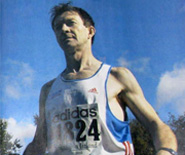The Maori People
I ran out of Hamilton with Roger my host in that city. We ran for an hour down some nice country roads parallel to route 1. Always great when you have local help running out of a large town or city. After an hour he headed back and I had my pack for the first time in a few days. In had lightened the load by asking Roger to mail some stuff on ahead to my Christchurch contact where my 32nd pair of running shoes are waiting for me almost 1,000km away on the south island. Whenever I start running with a backpack I always have too much. Without fail I pack it like I am Sylvester stallion, but I am only as strong as Tony the pony! Still even with that lightened load I struggled for two days, I will have to send on more stuff luxuries like cooking equipment and clothes when I get to Kates place in Taupo in a couple of days.
That first night I didn’t have an invitation for a place to stay so I ended up sleeping in an illegal camping place in a forest. Luckily it was a beautiful night and I hardly even needed my summer sleeping bag.
Dinner was a burger I picked up in the picturesque town of Cambridge that afternoon. In fact I had two places as a tough marathon runner called Kerry Suter had emailed me that day but as I don’t have internet on the run I didn’t know. At 10.15 when I was dozing off under the stars Paul Charteris – Race Director of Tarawera Ultra texted me to say he would pick me up on the road and next morning deliver me back today’s finish from his home in Rotorua some 50km away. I looked at the map, felt very comfortable lying there in the pines just 400 metres from the road. I suggested the following night which was fine with Paul. I was near Lake Karapira site of New Zealands ‘ center of excelence ‘ for their cycling and water sports athletes. The area is bursting with pride after a very sucessful medal haul in the recent London Olympic games.
So when Paul did pick me up on the road I photographed my finishing spot. He suggested we stop at a famous thermal hot springs but when I discovered it was 1km eachway on a trailhead I declined as it was too far! I was feeling bad about refusing the offer and when he suggested a dip in a lake I agreed. I stuck my little toe in the freezing cold water and cried out in pain, wimp that I am! As you can imagine I was delighted when Paul soon came running out for he was freezing too, not just me! There were two young tough Maori lads, built like oxen splashing about. One of them got out of the water came over to me sitting on a rock. He looked me in the eye.
I asked him if it was cold in the water, he told me no that it was alright. I asked him that if he was so tough does he think he could run around the world. Probably was his reply.
The Maori are the indigenous Polynesian people of New Zealand. The Maori originated with settlers from eastern Polynesia, who arrived in New Zealand in several waves of canoe voyages at some time between 1250 and 1300 CE.Over several centuries in isolation, the Polynesian settlers developed a unique culture that became known as the “Maori”, with their own language, a rich mythology, distinctive crafts and performing arts. Early Māori formed tribal groups, based on eastern Polynesian social customs and organisation. Horticulture flourished using plants they introduced, and later a prominent warrior culture emerged.
The arrival of Europeans to New Zealand starting from the 17th century brought enormous change to the Māori way of life. Māori people gradually adopted many aspects of Western society and culture. Initial relations between Māori and Europeans were largely amicable, and with the signing of the Treaty of Waitangi in 1840 the two cultures coexisted as part of a new British colony. Rising tensions over disputed land sales led to conflict in the 1860s. Social upheaval, decades of conflict and epidemics of introduced disease took a devastating toll on the Māori population, which went into a dramatic decline. But by the start of the 20th century the Māori population had begun to recover, and efforts were made to increase their standing in wider New Zealand society. Traditional Māori culture has enjoyed a revival, and a protest movement emerged in the 1960s advocating Māori issues.
In the 2006 census, there were an estimated 620,000 Māori in New Zealand, making up roughly 15% of the national population. They are the second-largest ethnic group in New Zealand, after European New Zealanders. In addition there are over 120,000 Māori living in Australia. The Maori language (known as Te Reo Maori) is spoken to some extent by about a quarter of all Maori, and 4% of the total population, although many New Zealanders regularly use Maori words and expressions, such as “kia ora“, in normal speech. Maori are active in all spheres of New Zealand culture and society, with independent representation in areas such as media, politics and sport.
Disproportionate numbers of Maori face significant economic and social obstacles, with lower life expectancies and incomes compared with other New Zealand ethnic groups, in addition to higher levels of crime, health problems and educational under-achievement. Socioeconomic initiatives have been implemented aimed at closing the gap between Maori and other New Zealanders. Political redress for historical grievances is also ongoing.
Paul told me he actually ran one of my favourite races during my competitive career, a 72 hour race called Across The Years. He ran it in 2007/8 the year I won it and crewed another year for a friend, a long way to go to crew for a race. The race begins in the twilight of the year and ends on New Years day, hence the name. A forest park worker and laughed when I told him I illegally camped in one of his forests last night!













January 27th, 2013 at 11:13 pm
That’s amazing about Paul in across the years race when you won it and meeting him in New Zealand 5 years later, it makes the world seem like a very small place though I’m sure it doesn’t seem that way to your legs !!!!